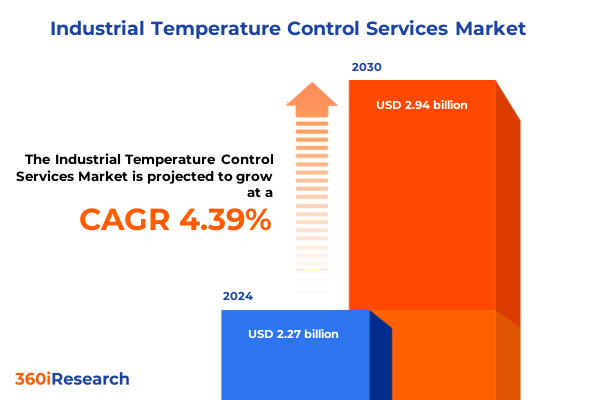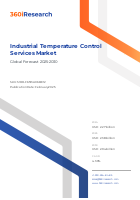The Industrial Temperature Control Services Market size was estimated at USD 2.27 billion in 2024 and expected to reach USD 2.38 billion in 2025, at a CAGR 4.39% to reach USD 2.94 billion by 2030.

Introduction to Industrial Temperature Control Services Landscape
The industrial temperature control services sector sits at the intersection of precision engineering and critical safety compliance, ensuring operational integrity across manufacturing, pharmaceutical, food processing and energy infrastructures. As regulatory mandates tighten around energy efficiency and environmental sustainability, stakeholders must navigate a landscape shaped by technological innovation and shifting trade policies. Today’s executive summary provides a concise gateway to the forces driving this market, outlines the structural divisions informing competitive strategy and highlights the regulatory and tariff considerations altering cost dynamics. By examining segmentation across system types, end-use industries, control technologies, service offerings, materials and organizational scale, this overview equips decision-makers with the insights needed to optimize capital allocation, streamline maintenance protocols and harness emerging digital tools. Ultimately, a clear grasp of regional nuances and the competitive profiles of leading service providers will guide effective partnership selection and inform actionable growth roadmaps.
Key Transformative Shifts Reshaping the Industry
Over the last five years, three transformative shifts have redefined the industrial temperature control space. First, the rapid integration of IoT-enabled sensors and analytics has moved predictive maintenance from pilot programs to mainstream operations, dramatically reducing unplanned downtime. Second, sustainability imperatives have elevated energy recovery units and renewable integrations from niche experiments to board-level priorities, aligning service roadmaps with global decarbonization targets. Third, digital control architectures-anchored by advanced building management systems and programmable logic controllers-have converged with legacy mechanical valves and thermostatic instruments to create hybrid ecosystems that optimize both precision and resilience. Collectively, these trends demand that service providers evolve from reactive repair shops into strategic technology partners, capable of delivering full-lifecycle solutions that balance reliability, efficiency and regulatory alignment.
Cumulative Impact of Newly Imposed U.S. Tariffs in 2025
The U.S. government’s implementation of new tariffs on imported chillers, control modules and polymer components in early 2025 has created a material shift in cost structures across the supply chain. Domestic manufacturers face higher input costs for stainless steel housings and specialized insulating polymers, leading service providers to recalibrate procurement channels and explore alternative material compositions. In response, several national OEMs have announced localized production expansions to mitigate exposure, while third-party installers evaluate dual-sourcing strategies to preserve margin integrity. Meanwhile, end-use industries in tariff-sensitive sectors such as automotive and petrochemicals are experiencing elevated maintenance budgets, prompting a re-prioritization of retrofit projects over greenfield investments. Ultimately, this tariff regime has accelerated the push toward regional supply networks and underscored the importance of flexible service contracts that can accommodate fluctuating component prices without eroding service quality.
Essential Market Segmentation Insights Driving Strategy
A nuanced understanding of market segmentation reveals where growth and differentiation intersect. The first segmentation by Type studies four categories: Air Conditioning Systems, Chillers, Heat Pumps and Process Heating Systems. Within Air Conditioning, centralized systems compete with decentralized alternatives. Chillers break down into absorption chillers, centrifugal chillers, energy-efficient chillers and reciprocating chillers. Heat Pumps classify into air source, ground source and hybrid configurations. Process Heating covers both hot water systems and steam management solutions.
End-Use Industry segmentation examines automotive applications-ranging from metal fabrication to paint and coatings-alongside chemicals across fertilizers, petrochemicals and polymer manufacturing; food & beverage tasks spanning beverage manufacturing, dairy products and meat processing; and pharmaceutical operations including biotech manufacturing and chemical synthesis.
Technology segmentation distinguishes IoT integration via predictive maintenance and smart thermostats from sustainable systems such as energy recovery modules and renewable energy integrations. Control Mechanism segmentation separates digital controls-represented by building management systems and programmable logic controllers-from mechanical controls like pressure-valve systems and thermostatic regulators. Service Type segmentation contrasts installation and setup, with custom installations and retrofit services, against maintenance and repair offerings that include emergency repair solutions, remote monitoring services and routine maintenance contracts. Material segmentation differentiates metal-based systems-aluminium and stainless steel components-from polymer-based assemblies featuring insulating polymers and thermo-conductive materials. Finally, Capacity segmentation considers large enterprises, from industrial parks to mass production facilities, versus small-medium enterprises, such as boutique manufacturers and cottage industries.
This comprehensive research report categorizes the Industrial Temperature Control Services market into clearly defined segments, providing a detailed analysis of emerging trends and precise revenue forecasts to support strategic decision-making.
- Type
- End-Use Industry
- Technology
- Control Mechanism
- Service Type
- Material
- Capacity
Critical Regional Dynamics and Their Strategic Implications
Regional dynamics play a pivotal role in shaping service design and delivery. Within the Americas, North American clients demand rigorous compliance with energy-use regulations and embrace advanced digital controls, while Latin American manufacturers often prioritize affordability and local support networks. In the Europe, Middle East & Africa cluster, Western European markets drive the adoption of sustainable heat recovery systems under stringent efficiency mandates, the Middle East anchors growth around oil and gas temperature regulation, and emerging African manufacturing hubs show increasing interest in modular chillers and remote-monitoring services. The Asia-Pacific region stands out for its volume-driven opportunities: heavily industrialized economies in China, India and Southeast Asia invest heavily in automation, smart thermostat roll-outs and hybrid heat pump solutions to meet surging energy demands and environmental targets.
This comprehensive research report examines key regions that drive the evolution of the Industrial Temperature Control Services market, offering deep insights into regional trends, growth factors, and industry developments that are influencing market performance.
- Americas
- Asia-Pacific
- Europe, Middle East & Africa
Key Companies Shaping the Competitive Arena
Competitive leadership rests with a blend of global conglomerates and specialized service firms. Industry stalwarts such as Honeywell International Inc., Siemens AG, Schneider Electric SA and Johnson Controls International PLC maintain dominant positions through integrated building management systems and programmable logic controllers. General Electric Company and Mitsubishi Corporation leverage expansive industrial portfolios to supply end-to-end temperature control solutions. Specialist installers and rapid-response teams-Accurate Temperature Control Corporation, Independent Temperature Control Services, Inc., Temperature Control Services, Inc., Temperature Control Services, LLC and Temperature Service Company-distinguish themselves with custom installation and maintenance contracts tailored to client uptime imperatives. Precision and bench-scale instrumentation providers including Julabo GmbH, Oven Industries Inc., Wavelength Electronics, Inc. and UNION Instruments GmbH focus on laboratory and niche process heating applications. Rental and modular solution leaders Aggreko PLC and E-Control Systems, Inc. meet variable demand with scalable chillers and temporary temperature control units. Mid-tier experts Altech Mechanical Service Co., CK Control Temp Inc., Dual Temp Co Inc., Precision Temperature Control, Inc., Rasmussen Mechanical Services and Thermo Fisher Scientific, Inc. serve specialized sectors from biotech manufacturing to polymer processing, while Building Automation Solutions continues to drive smart thermostat and energy recovery system integrations.
This comprehensive research report delivers an in-depth overview of the principal market players in the Industrial Temperature Control Services market, evaluating their market share, strategic initiatives, and competitive positioning to illuminate the factors shaping the competitive landscape.
- Accurate Temperature Control Corporation
- Aggreko PLC
- Altech Mechanical Service Co.
- Building Automation Solutions
- CK Control Temp Inc.
- Dual Temp Co Inc.
- E-Control Systems, Inc.
- General Electric Company
- Honeywell International Inc.
- Independent Temperature Control Services, Inc.
- Johnson Controls International PLC
- Julabo GmbH
- Mitsubishi Corporation
- Oven Industries Inc.
- Precision Temperature Control, Inc.
- Rasmussen Mechanical Services
- Schneider Electric SA
- Siemens AG
- Temperature Control Services, Inc.
- Temperature Control Services, LLC
- Temperature Service Company
- Thermo Fisher Scientific, Inc.
- UNION Instruments GmbH
- Wavelength Electronics, Inc.
- Yokogawa Electric Corporation
Actionable Recommendations for Industry Leaders
Industry leaders should prioritize three strategic imperatives. First, accelerate the digitization of maintenance routines by embedding IoT sensors in critical heating and cooling loops to achieve predictive analytics and minimize downtime. Next, diversify supply chains by qualifying alternate manufacturers of polymer-based insulation and stainless steel components to shield service margins from tariff volatility. Finally, deepen regional partnerships by co-developing pilot programs with local clients in emerging markets-especially within the Asia-Pacific and Africa clusters-to tailor solutions that address specific regulatory and infrastructure challenges. By executing these actions in parallel, executives can enhance resilience, unlock new revenue streams and position their organizations at the forefront of sustainable temperature control services.
Explore AI-driven insights for the Industrial Temperature Control Services market with ResearchAI on our online platform, providing deeper, data-backed market analysis.
Ask ResearchAI anything
World's First Innovative Al for Market Research
Conclusion: Positioning for Future Success
In summary, the industrial temperature control services market stands at a pivotal crossroads defined by technological innovation, regulatory pressure and trade policy headwinds. Organizations that harness advanced digital controls, align their supply chains to tariff realities and refine their service portfolios through targeted segmentation will unlock competitive advantage. Moreover, a keen eye on regional market nuances-from energy-efficiency priorities in Europe to volume-driven automation in Asia-Pacific-will guide optimal resource allocation. Ultimately, success will favor those who transform from reactive maintenance providers into proactive strategic partners, delivering measurable efficiency gains, reduced emissions and enhanced operational reliability.
This section provides a structured overview of the report, outlining key chapters and topics covered for easy reference in our Industrial Temperature Control Services market comprehensive research report.
- Preface
- Research Methodology
- Executive Summary
- Market Overview
- Market Dynamics
- Market Insights
- Cumulative Impact of United States Tariffs 2025
- Industrial Temperature Control Services Market, by Type
- Industrial Temperature Control Services Market, by End-Use Industry
- Industrial Temperature Control Services Market, by Technology
- Industrial Temperature Control Services Market, by Control Mechanism
- Industrial Temperature Control Services Market, by Service Type
- Industrial Temperature Control Services Market, by Material
- Industrial Temperature Control Services Market, by Capacity
- Americas Industrial Temperature Control Services Market
- Asia-Pacific Industrial Temperature Control Services Market
- Europe, Middle East & Africa Industrial Temperature Control Services Market
- Competitive Landscape
- ResearchAI
- ResearchStatistics
- ResearchContacts
- ResearchArticles
- Appendix
- List of Figures [Total: 30]
- List of Tables [Total: 1121 ]
Connect with Ketan Rohom to Access the Full Report
To explore these insights in depth and gain a complete understanding of the methodologies, data sources and proprietary frameworks underpinning this analysis, connect with Ketan Rohom, Associate Director, Sales & Marketing, to purchase the comprehensive market research report.

- How big is the Industrial Temperature Control Services Market?
- What is the Industrial Temperature Control Services Market growth?
- When do I get the report?
- In what format does this report get delivered to me?
- How long has 360iResearch been around?
- What if I have a question about your reports?
- Can I share this report with my team?
- Can I use your research in my presentation?




